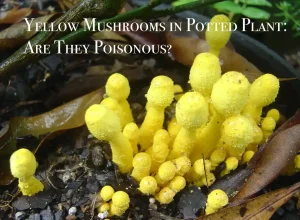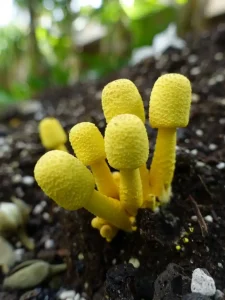
Have you ever found yellow mushrooms sprouting in your potted plants? If so, you might be wondering if these mushrooms are harmful to your plant or yourself. In this article, we’ll explore everything you need to know about yellow mushrooms in houseplants and learn how to treat them properly.
Identifying Yellow Mushrooms
Yellow mushrooms (Leucocoprinus birnbaumii) also known as the flowerpot parasol, are frequently observed growing in the potting soil of indoor plants. It begins as a pale yellow fuzzy patch on the surface of the soil and eventually matures into large parasol-shaped mushrooms. These mushrooms release spores, which are tiny, often barely visible “seeds” that can give rise to new fungi.
In potted plants, they often grow due to the presence of dead organic matter in the potting mix. They feed on this decaying organic matter, and their little yellow split gill and bell-shaped caps make them easy to spot amidst the greenery of your houseplants. In addition, yellow mushrooms are a moisture-loving plant, they will thrive in the condition of wet weather or waterlogged soil.
Life cycle
A vibrant yellow soft patch appears on the surface of your potting soil, and within a few hours, it begins to form small lumps that protrude one to two inches tall above the soil. These lumps transform into fully-grown yellow mushrooms with a parasol-like shape. The mushrooms initially have a bright yellow hue, but as the day progresses, they may transition to a light orange or even white color. As the mushrooms dry out over the next few hours, they become a sticky mess on the soil surface. The small yellow mushroom blossoms typically last for 1 to 2 days.
Toxicity Potential?
The yellow houseplant mushroom does not pose a threat to your live plants, as it thrives on decaying organic matter in the soil, such as dead leaves, wood fragments, and other debris. As long as your plant is flourishing, it is not vulnerable to this fungus. These mushrooms are just a natural component of the ecosystem, carrying out their role in a potted soil environment within your home.
For your health and your pet, they are generally non-toxic and some types of mushrooms are edible, but it is important to be cautious and avoid ingesting any unidentified mushrooms discovered in your houseplants. It is advisable to handle this yellow mushroom with care, wearing plastic gloves, as some individuals may have allergies to certain fungi and their skin may have a negative reaction to contact with a mushroom.

How To Get Rid Of Yellow Mushrooms?
Yellow mushrooms’ appearance can indicate a problem with your potting mix or watering habits. While they won’t hurt your plant directly, they may be a sign of decay or excess moisture in the soil. Then if you find small yellow fungi in your potted plant, you can consider choosing one of the following methods to prevent them.
Removing mushrooms
This fungus grows rapidly, so you can anticipate seeing outcomes in just a few weeks. Although you can physically pick and eliminate the mushrooms, this only addresses the surface level of the fungus. It is incredibly difficult to eliminate all of the mushroom spores and mycelium from the potting soil, which can lead to the growth of more mushrooms in the future. However, it’s best to attempt removing the mushrooms as soon as they appear, before mushrooms growing again, eliminating the risk of them re-sporing – unless the spores are coming from another source.
Furthermore, maintaining a regular watering schedule that doesn’t keep the soil too damp or rot the root, will decrease the likelihood of the fungus producing any mushrooms.
The most complex and risky action would be to replace all the soil from the plant’s roots. This could send the plant into shock. At this point, you may want to discard your entire houseplant, garden, and pot.
Environmental Improvement
You may want to consider altering the plant’s environment – such as lower temperatures, reduced humidity, drier soil, or increased air circulation. This could help decrease mushroom growth. However, be aware that these changes may hurt your plant, as the conditions favorable for most houseplants are also ideal for mushroom growth.
Solarizing soil
- Clear the area of any debris and disperse any large clumps of soil.
- Completely saturate the soil with water.
- Pack soil into transparent plastic bags. In a warmer climate, opt for black plastic bags to retain more warmth.
- Alternatively, secure plastic sheeting tightly over mounds of soil. Ensure the covered soil is in a spot that gets the most sunlight.
- Allow the soil to rest for four to six weeks. This process will eliminate pests, weeds, undesired seeds, and fungal spores while decomposing plant material and enhancing its nutrient levels.
Sterilization
Ensuring the potting mix is sterilized before planting seeds will prevent the growth of unwanted pests or weeds in your pots. Sterilizing soil can be done through steaming, microwaving, or using an oven, with a temperature of 180 degrees Fahrenheit (82 degrees Celsius) needed before exposure to sunlight. Solarizing, on the other hand, utilizes the sun’s energy to heat and sterilize the soil, using either clear or black plastic.
Fungicides
Fungicides are commonly used on plants to prevent fungal illnesses. They are typically sprayed on leaves or soil. While fungicides are generally safe to use, some people may develop mild allergies to them. However, since they are not completely effective in disease control, it is best to avoid using them unless necessary.
